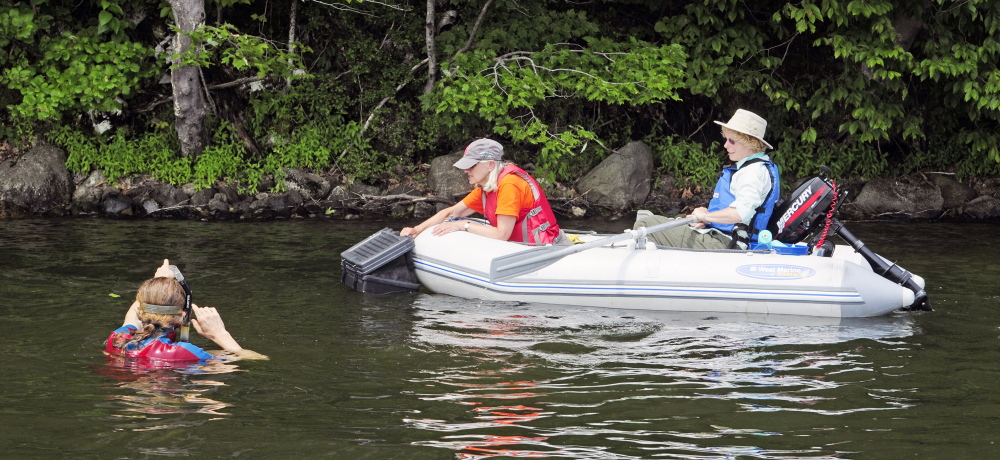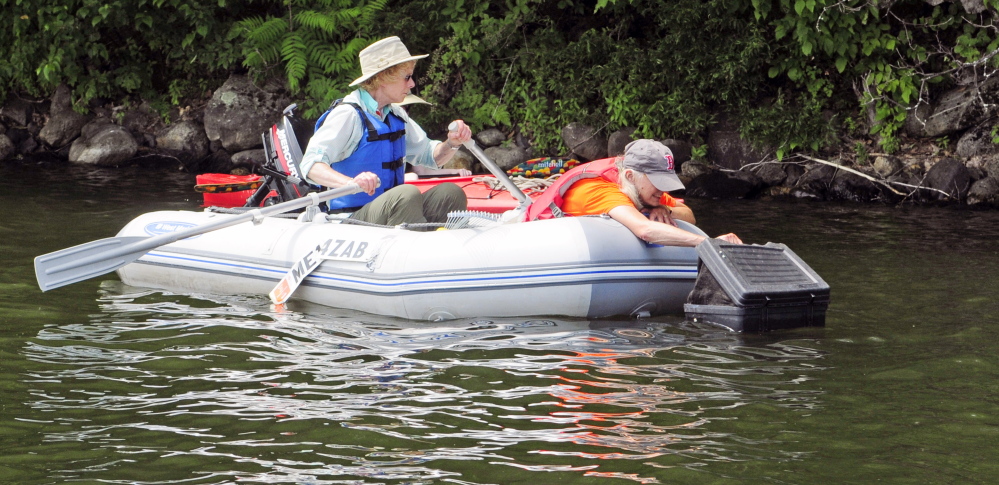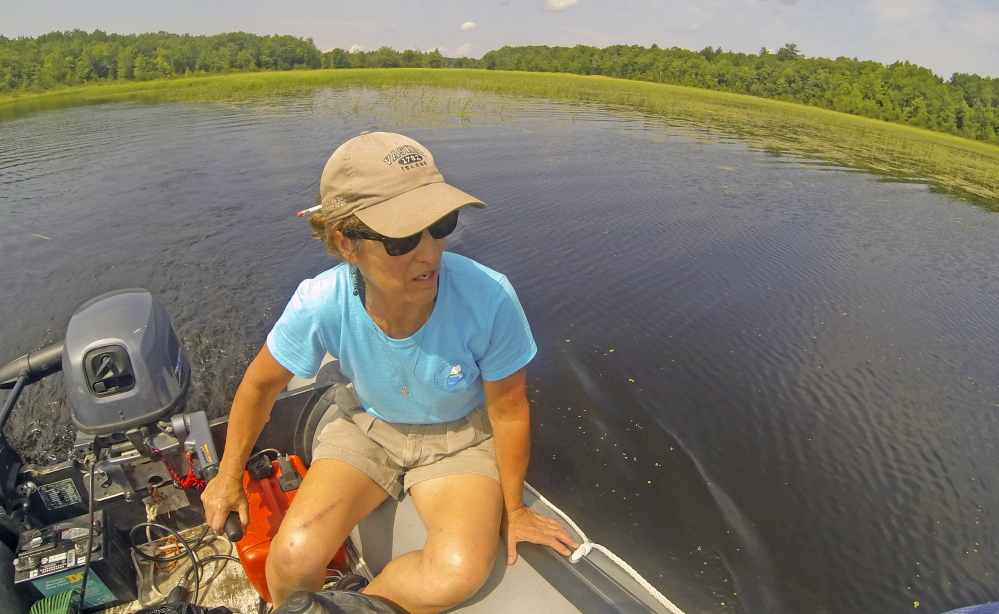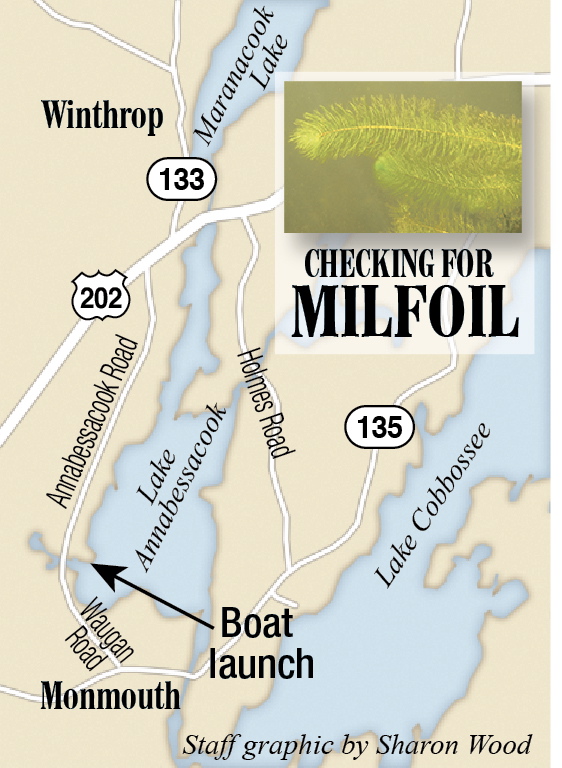WINTHROP — More than two dozen people fanned out across Annabessacook Lake Thursday armed with rakes, maps and even a mask and snorkel, searching for something they hope to never find: milfoil.
The searchers, made up of government andnonprofit organization employees and volunteers, took to kayaks, canoes and boats to search for the invasive plant variable water-milfoil. Organizers hope to search much of the lake’s shoreline and develop a cadre of shoreline property owners, and others with interest in the lake, to stay vigilant for invasive plants in the future.
“The threat of aquatic invaders in a state as water rich as Maine is formidable,” said Paul Gregory, environmental specialist with Department of Environmental Protection’s invasive species program. “A project like this shows exactly what is needed to address such a challenge.”
A boat inspector working at the Waugan Road boat landing last August discovered variable water-milfoil fragments floating in the water around the landing. Nearby lakes in Belgrade and Oakland have been infested with the milfoil, which is the most prevalent invasive aquatic plant in Maine.
But there is no known infestation in Annabessacook, said Roberta Hill, invasive species program director for the nonprofit Maine Volunteer Lake Monitoring Program. The fragments could have floated in from another lake, or perhaps as a stowaway on a boat. The aim of Thursday’s search was to determine if there is an unknown infestation.
“The only way to answer this question with certainty is to conduct a comprehensive screening survey of the lake’s entire shoreline,” Hill said. “Many eyes make light work.”
The day began at the Winthrop Town Office, where Hill provided an overview of the search and instruction on how to identify invasive plants. The lake was broken down into 10 areas that were assigned to groups of volunteers. The DEP had already searched one of those areas, the one closest to the boat launch.
Hill cautioned the volunteers to collect only samples rather than pulling up the whole plant because it would make it difficult to go back and remove the root. She told the volunteers to collect samples, write down pertinent information, and mark the area with a buoy.
“If you see anything suspicious don’t hesitate to grab a sample of that as well,” Hill said.
She encouraged those who crossed paths with property owners and other boaters to share their story and encourage their assistance.
“It’s a perfect opportunity to educate and engage,” Hill said.
The searchers face a ticking clock. Within a couple weeks the growth of planktonic algae could decrease water visibility enough to make a thorough screening impossible, Hill said.
“Support from the community has been remarkable,” she said. “Nonetheless, conducting a complete survey on a lake that is nearly 1,500 acres in size is a somewhat daunting task for novice surveyors.”
Hill’s organization, along with the DEP, and area watershed districts, have provided training for search volunteers. Search volunteer Sue Neal, president of the Annabessacook Lake Association, said there has been a good turnout of people willing to help.
Neal hopes the milfoil has not taken root in the lake, but that is not her biggest fear.
“My concern is we won’t find it, that we’re not going to search where it’s hiding,” she said.
The area around the Waugan Road boat launch is so thick with aquatic plants that only a channel formed by Wilson Stream is open to take boaters to the main part of the lake. It is a nearly ideal spot for an invasive aquatic plant species. Hill said many boat landings are built on public property in undesirable spots with shallow, soft bottoms.
“The problem with that is those areas are highly susceptible to invasive plants,” Hill said.
The ideal conditions for searching for invasive plants is water that is flat as glass and lots of sunlight. Hill, who had never before been on Annabessacook, said Thursday’s conditions — sunny and slightly hazy — were not ideal, but still favorable.
“Bright sun is good and it’s good if it’s not perfectly clear,” Hill said. “The water clarity is pretty good.”
Once out on the lake, Hill motored to the southeast shore of Big Island where a team checked for signs of invasive plants. Volunteer Kent Ackley, outfitted with a wet suit, mask and snorkel, periodically dove under water to examine plants and take samples to the top. Two of those samples proved to be native slender naiad and northern snail-seed pondweed.
“They look quite a lot alike,” Hill said. “It just takes a little practice to tell them apart.”
Nearby, a team in a canoe paddled near shore as one leaned over the bow and peered into a black box that Hill called a scope. The device allows users to look under water without surface glare.
“It’s like a diver’s mask,” Hill said. “A snorkel is a great way to look, but you couldn’t do a whole lake that way.”
Hill said the steeply sloped bottom is unlikely to have invasive milfoil, but the search moved much faster in areas where there are few native plants.
“The areas that take time are where there are thick plants,” she said.
Samples collected during the survey, and in the future, will be tested to determine if they are an invasive species. Hill said the fragment found last August likely fell off a boat that had just been pulled from the water. The same boat had recently been used in an infected pond.
“We don’t know. That’s why we’re here,” Hill said. “If there is variable milfoil in the lake it probably is not well established.”
Neal, of the lake association, said the lake has faced a number of threats, such as oil and sewerage seeping into the lake, since she moved there in the 1960s.
“We’ve dealt with a lot of problems,” she said. “We’ve dealt with it and we’ll deal with this.”
Craig Crosby — 621-5642
Twitter: @CraigCrosby4
Send questions/comments to the editors.






Success. Please wait for the page to reload. If the page does not reload within 5 seconds, please refresh the page.
Enter your email and password to access comments.
Hi, to comment on stories you must . This profile is in addition to your subscription and website login.
Already have a commenting profile? .
Invalid username/password.
Please check your email to confirm and complete your registration.
Only subscribers are eligible to post comments. Please subscribe or login first for digital access. Here’s why.
Use the form below to reset your password. When you've submitted your account email, we will send an email with a reset code.